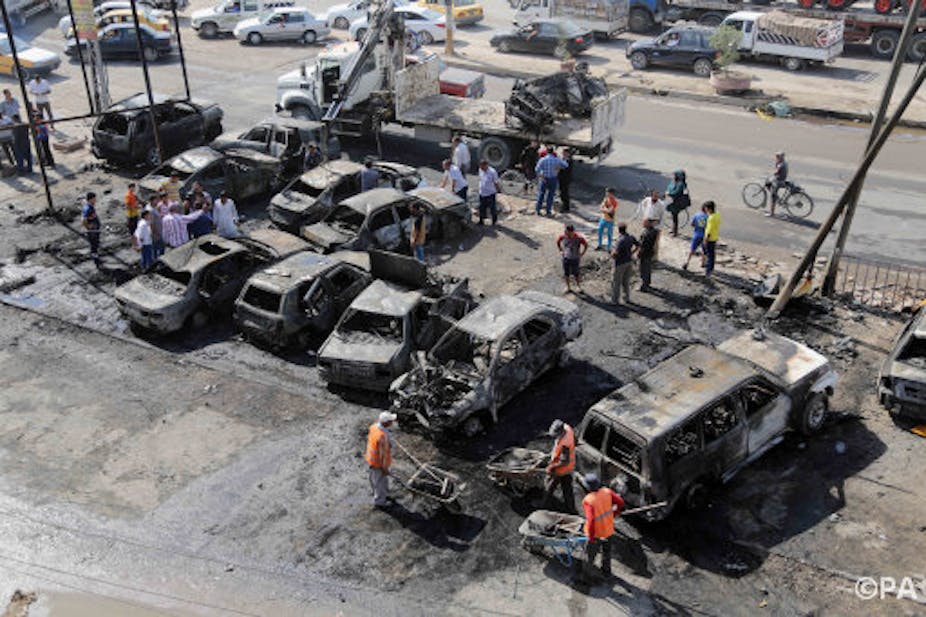Things have not been going well in Iraq for a while. Sectarian violence is on the increase, having reached levels last seen in 2008. As a consequence, the government of Nouri al-Maliki is in dire straits. The same prime minister who negotiated a restrictive status-of-forces agreement with the United States in 2008, now comes begging to Washington for military aid and support.
We are seeing old tensions and new combine, pushing Iraq once again to the edge of a very steep cliff. In 2008, sectarian violence was at a high level, but the trend was downward from the heights of the civil war that started in earnest in 2006; now the trend is, if anything, upwards.
The violence in Iraq is part of a broader and very dangerous pattern of sectarian confrontation across the Middle East that is playing out in places such as Bahrain, and above all Syria, as a proxy war between Iran and Saudi Arabia that feeds, and feeds off, local tensions. In the case of Iraq, these local tensions between Shia and Sunnis date back to well before the 2003 intervention.
The removal of Saddam Hussein’s dictatorship and the de-Baathification that followed it were seen by Shia Muslims as an opportunity to right the wrongs of the past. Sunni Muslims, have seen the same process as the beginning of a period of repression and discrimination thinly veiled as victor’s justice. The drafting of the 2005 interim constitution – both in process and outcome – reflected few, if any, Sunni concerns. National elections in 2005, were widely boycotted by Sunni political parties and candidates. As a – self-inflicted – consequence, they did not gain any effective representation in national institutions.
The political and economic exclusion that Sunnis experienced, particularly in light of their previously more privileged position as a community under Saddam Hussein, led to the 2006-2008 civil war. It provided a context in which al-Qaeda could gain a major foothold in the country, grafting itself onto a local Sunni insurgency with the far more limited objective of fighting back against an increasingly repressive Shia-led government.
Attempts by al-Qaeda in Iraq to trigger a full-scale sectarian war eventually failed. US and Iraqi government strategies changed significantly during the course of the 2006-2008 civil war, eventually leading to an arrangement with Sunni tribes that drove al-Qaeda out of Iraq and paved the way towards more inclusive policies that placated at least some of the concerns of Sunni communities and their leaders about security, political participation and economic development.
Yet, following the 2010 elections, protracted negotiations over the formation of a new government coalition by al-Maliki, the partial exclusion and partial persecution of Sunni leaders (which was already apparent in the run-up to the those elections) led to a worsening of Sunni-Shi’a relations once again. Exacerbated by continuing insecurity, political instability, lack of economic development and the regional turmoil caused by the Arab Spring, the violent escalation of tensions was inevitable.
Second wave of violence
The most likely trigger of the current cycle of violence was the government crackdown on a protest by Sunnis in Haweeja in April 2013: the breaking-up of a sit-in that had been running for three months as a statement against the perceived unfair treatment of Sunnis prompted a significant backlash.
In this sense, the second cycle of major civil violence in Iraq was caused, in large measure, by the same exclusionary and discriminatory policies against Sunnis that contributed to the 2006-2008 civil war. Then, as now, it creates an opening for al-Qaeda to infiltrate a highly volatile local context and exploit it for its own wider agenda.
Crucially though for our understanding of the situation in Iraq, the Sunni-Shi’a divide is only one of many problems that were never fully resolved in the aftermath of the 2003 US-led intervention.
Divides among the Shia remain, both in regional and political terms. The initial alliance between Shia and Kurds against Sunnis has given way to increasing acrimony between the Kurdish Regional Government in Erbil and the Shia/Maliki-led coalition government in Baghdad, in which the Kurds are officially a partner. There has also been more co-operation between Kurds and Sunnis.
In this context of multiple sources of instability, the ongoing confrontation between Erbil and Baghdad over the future of the so-called disputed territories, especially over oil-rich Kirkuk, remains the other major security concern alongside sectarian violence.
While not at the stage of an all-out Arab-Kurdish civil war (yet), this simmering conflict has potentially far-reaching consequences in its ability to trigger not just a civil war in Iraq, but an armed confrontation that could easily draw in Iraq’s neighbours Syria, Iran, and Turkey. Each of these countries has its own Kurdish populations and each has strategic interests in a reconfiguration of power and influence in the region.
Stepping back from the edge
The Arab-Kurdish dispute in Iraq partially overlaps with the wider sectarian confrontation in the Middle East and, as such, also has the potential to draw in Saudi Arabia and its Gulf allies. A further escalation of the violence in Iraq to the regional level is a scenario that will leave behind more losers than winners among states -– and no winners among the civilians that are likely to bear the brunt of the costs and consequences of such escalation.
The key task for the Iraqi government, its regional and international partners and for Sunni and Kurdish leaders, therefore is to work together towards de-escalation of the volatile situation in Iraq. Sunnis must be given a meaningful voice in Iraqi politics and they must in turn be willing to accept opportunities to participate. Iraq needs to become a fairer and more just society for all its communities and their individual members regardless of their ethnic or religious identity. On that basis, communities and their political and religious leaders can build the trust that is necessary to tackle Iraq’s multiple problems in a constructive and sustainable way.

